
Delivering freight decarbonisation: Strategies for reducing Australia’s transport emissions
Recommendations for short- and long-haul freight
This report from Climateworks Centre, with input in review stages from CEFC Director – Infrastructure Julia Hinwood, focuses on opportunities to reduce emissions from road freight with solutions that span the entire freight sector.
About this report
Delivering freight decarbonisation: Strategies for reducing Australia’s transport emissions
October 2023
Delivering freight decarbonisation: Strategies for reducing Australia’s transport emissions was developed by Climateworks Centre, with input in review stages from CEFC Director – Infrastructure Julia Hinwood. It provides a suite of freight decarbonisation solutions to help Australia reach its emissions targets and improve other outcomes such as productivity and impacts on health and liveability.
Read moreTransport is a major contributor to Australia’s emissions, and freight is a significant component of that. This report highlights solutions, many of which are already available, that can decarbonise short- and long-haul freight and support Australia’s transition to net zero.Julia HinwoodDirector - Infrastructure, CEFC
about the Sector
The transport sector contributed approximately 20 per cent of Australia’s domestic emissions in 2021. The Department of Climate Change, Energy, the Environment and Water predicts it is likely to become the largest contributor by 2030.
Freight makes up just under 40 per cent of total transport emissions.
Total freight transport emissions were estimated to be approximately 36 MtCO2-e in 2020. Australian freight activity amounted to 795 billion tonne kilometres transported mainly by road, rail, domestic maritime shipping and air in 2022. A medium growth-rate scenario suggests this activity will increase by 26 per cent between 2020 and 2050.
Road freight emissions are about five times those from rail and domestic shipping put together, despite accounting for only a third of freight activity. If there is no change to the way road freight is carried across the country, growing freight activity will lead to an absolute increase in emissions.
Role of the CEFC
The CEFC is working to demonstrate the potential to decarbonise transportation through electrification and mode switching.
Our work with supply chain and logistics company Qube on the Moorebank Logistics Park has helped transform the way containerised freight moves through Sydney by increasing the use of rail to replace road freight. Moorebank Logistics Park also uses energy efficient automation powered by renewable energy generated on site.
The CEFC also works with some of Australia’s leading infrastructure funds to decarbonise substantial infrastructure portfolios that include major transport assets such as ports and airports. These critical infrastructure assets can play a key enabling role in decarbonisation of heavy transport by hosting supporting infrastructure.
report findings
There are three trends which Australia can build on by creating a sector-wide decarbonisation plan that charts a path forward for transport.
The three trends are:
- Growing original equipment manufacturer interest in medium-heavy duty zero-emissions trucks
- Increasing regulatory pressure to report on scope 3 emissions
- Climate-focused policies in Australia that can support freight decarbonisation.
The report makes an overall recommendation to set a pathway to freight transport decarbonisation with clear interim targets.
Recommendations for short-haul freight:
- Unlock supply of zero-emissions trucks by revising weight limitations on heavy vehicles and formulating regulations that boost availability
- Build demand for zero-emissions trucks and vehicles by making them competitive assets for business investment
- Build an environment that supports market innovations and optimisation.
Recommendations for long-haul freight:
- Undertake a comprehensive cost-benefit analysis to determine optimal roles for different modes, fuels and technologies
- Make rail a competitive mode-choice for long-haul freight
- Reduce technological uncertainty by providing guidance, supporting vehicle trials and demonstrating integrated use-cases for long-haul trucks
- Set a clear role for advanced biofuels.





